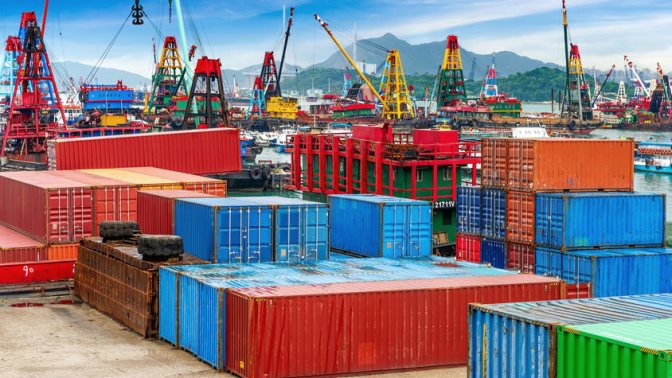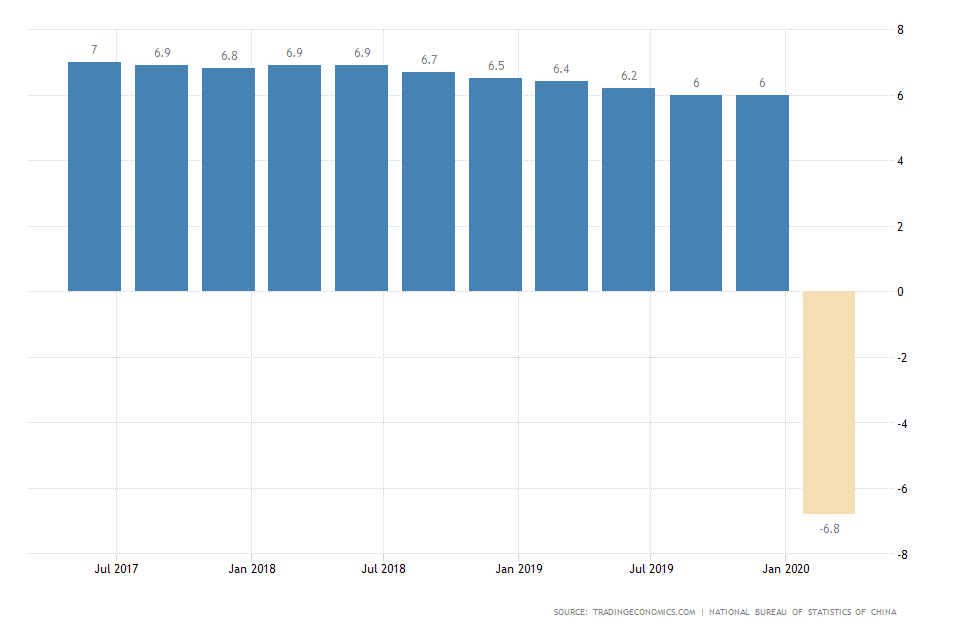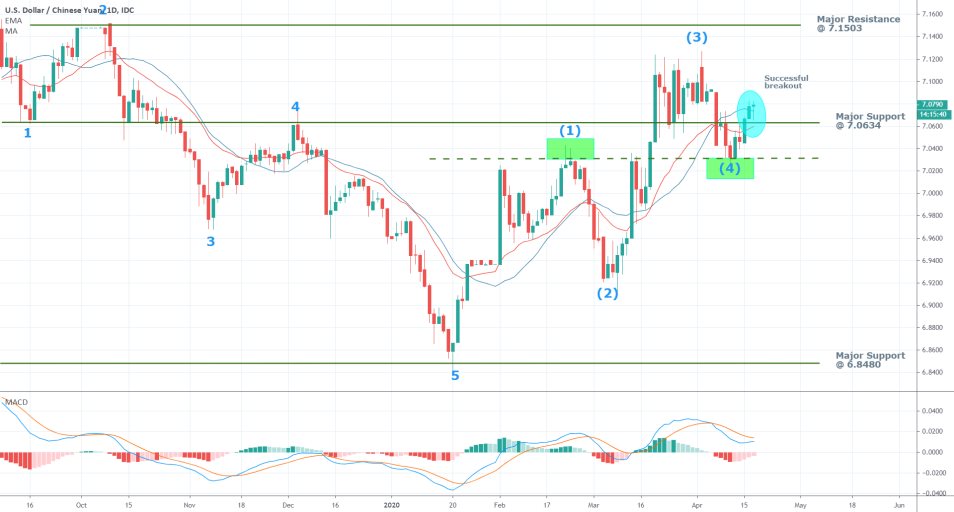
According to the National Bureau of Statistics of China, the annualised GDP growth rate in the first quarter of 2020 shrank by 6.8 per cent, which is the first contraction since 1992.
The sharp tumble was prompted by the coronavirus pandemic, which caused massive lockdowns in China in the first months of the year, and also forced a virtual suspension of almost all industrial activity in the Chinese economic heartland in and around Hubei.
The 6.8 per cent slump in the growth rate is in stark contrast compared to the 6 per cent growth that was recorded the previous quarter, and it also missed the market expectations for a 6.5 per cent fall in the three months to March.

The worse-than-expected results outlined in NBS's report for Q1 of 2020 illustrate a deeper economic downturn than previously anticipated, which poses a more substantial challenge for the eventual recovery.
Nevertheless, there are Chinese and global economic systems put in place that can safeguard the gradual process of economic stabilisation.
As we showed in our ‘Market Update’ from the 15th of April, the Chinese balance of trade (BoT) data for the same period underscores the resilience of the global supply chains, which is a prerequisite for economic normalisation in China and elsewhere.
“The USD 7 billion trade deficit, which was incurred in January and February at the height of the COVID-19 crisis in China, has been thwarted in March, with better-than-expected import and export numbers. […] the moderately better-than-expected performance (regarding the BoT numbers) in the wake of the crisis gives investors a glimmer of hope for quick recovery. This happens as the Chinese industrial activity starts to normalise, and individuals return to their workplaces.”
More optimistic economists are now hoping for a V-Shaped recovery, which implies a snap throwback of the GDP growth rate into positive territory from the very next quarter, as the underlying economic activity is resumed after the lockdowns.
More sceptical specialists, however, argue that the underlying conditions, such as the markedly subdued global demand compared to the pre-crisis levels, are less favourable and cannot support a V-Shaped snap recovery.
Instead, they caution that a longer and more gradual recovery process would take place after the pandemic is over.
Due to such gloomier outlooks for global recovery, the Chinese Yuan continues to be pressured as international trade prospects remain feeble despite the demonstrated resilience of the supply chains.
The USDCNY broke out above the major resistance level (currently support) at 7.0634, and now looks set to complete the 1-5 impulse wave pattern.

Trendsharks Premium
Gold is undergoing a correction, as investors take profits to offset losses from falling stock prices, impacting their margins. However, we anticipate a renewed wave of [...]
The Swiss stock market index is mirroring its global counterparts, such as Germany 40 and US100, experiencing a sharp decline following the announcement of new [...]
We’re analyzing the weekly chart to grasp the broader market trend. Over the past three years, the US30 index has surged by 17,000 points, often resembling a nearly straight [...]
Over the past week, the DAX has experienced a sharp decline, plunging by an astonishing 3,400 points. This downward movement is not isolated, as its international counterparts, such as the UK100 and US100, are also facing significant [...]
EURUSD recently formed a double top at 1.0930, signaling a potential trend reversal, and has since begun a correction. After a 600-pip rally since early March, a pullback at this stage is both expected and healthy. Given these conditions, we are placing a [...]
Since early March, EURJPY has surged nearly 1,000 pips, providing us with several excellent trading opportunities. However, as the rally matures, many early buyers are beginning to take profits, leading to a noticeable slowdown in the uptrend. On Friday, the pair formed a [...]
The AUDJPY currency pair continues to be dominated by bullish momentum, as multiple golden cross patterns reaffirm the strength of the ongoing uptrend. Despite this, we are witnessing a much-needed [...]
The EURAUD currency pair appears to be undergoing a trend reversal, signaling a potential shift in market direction. A notable technical development is the formation of a Death Cross on the chart, a widely recognized bearish indicator that typically suggests a [...]
After securing an impressive 200-pip profit last week, the EURJPY currency pair is now undergoing a southward correction, retracing some of its recent gains. Despite this temporary pullback, the Golden Cross remains intact, reinforcing our view that the overall trend continues to be [...]
The appearance of a Golden Cross in Silver strengthens our analysis that the metal is currently in a strong uptrend, indicating further bullish momentum in the market. This technical pattern, where the short-term moving average crosses above the [...]
This trade presents a considerable level of risk and can be classified as an opportunistic move based on recent price action. The GBPUSD currency pair has experienced a substantial bullish rally, surging by nearly 500 pips in a strong upward movement. However, after this extended period of appreciation, the pair is showing signs of a potential [...]
The anticipated Death Cross on the SMI20 appears to be failing as price finds strong support at the 23% Fibonacci retracement level. After testing this area, the index has shown bullish strength, printing several large green candles, signaling an increase in [...]
A Golden Cross has just appeared on the USDJPY chart, signaling a potential bullish move. This technical pattern occurs when the 20 period moving average crosses above the 60 period moving average, a widely recognized indication of increasing [...]
After 2 months of a down trend, we finally see some indications of price recovery for Oil. The golden cross, a historic buy signal, supports this [...]
For the past month, the German DAX40 has experienced a remarkable 10% surge, reflecting strong bullish momentum. Despite ongoing market volatility and frequent pullbacks, every dip continues to attract fresh buyers, reinforcing the [...]
Oil continues its downward trajectory, despite occasional pullbacks. The overall trend remains bearish, reinforced by multiple Death Cross patterns, a classic sell signal indicating further weakness. Adding to this bearish outlook, the critical [...]
Over the past few days, gold has experienced a sharp decline of more than $100. This downturn can be attributed in part to traders securing profits to manage their margins, which are under strain due to the significant drop in major indices. Currently, gold has fallen below the [...]
The NASDAQ 100 index is showing strong bullish momentum, as evidenced by the formation of a Golden Cross on the chart. This classic buy signal occurs when the short moving average crosses above the long term moving average, suggesting that upward momentum is [...]
The EURAUD currency pair has encountered a significant resistance level, failing to break above the critical 61% Fibonacci retracement level. This suggests that bullish momentum is weakening, reinforcing the case for a potential downward move. Given this technical setup, we favor entering a [...]
The UK100 is experiencing a remarkable rally! Over the past few weeks, the British stock market index has surged nearly 800 points. Each minor dip has attracted more buyers, fueling the bullish momentum. However, since last week, we’ve observed a slight [...]




















